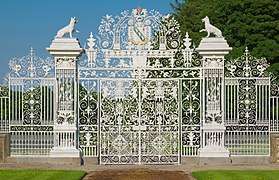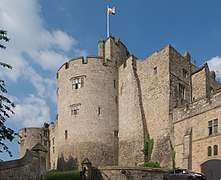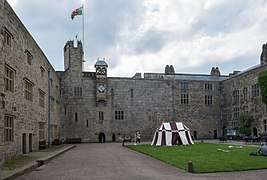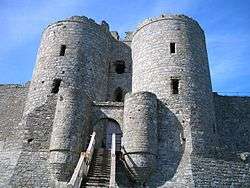Chirk Castle
Chirk Castle (Welsh: Castell y Waun) is a Grade I listed castle located at Chirk, near Wrexham, Wales.[1][2]
| Chirk Castle | |
|---|---|
Castell y Waun | |
Chirk Castle | |
 Location within Wrexham | |
| General information | |
| Type | Castle / Stately home |
| Location | Chirk, near Wrexham |
| Coordinates | 52°56′06″N 3°05′23″W |
| Completed | 1295 |
| Owner | National Trust |
| Website | |
| https://www.nationaltrust.org.uk/chirk-castle | |
Listed Building – Grade I | |
| Designated | 20 October 1952 |
| Reference no. | 598 |
History
The castle was built in 1295 by Roger Mortimer de Chirk, uncle of Roger Mortimer, 1st Earl of March as part of King Edward I's chain of fortresses across the north of Wales. It guards the entrance to the Ceiriog Valley. It was the administrative centre for the Marcher Lordship of Chirkland.
The castle was bought by Sir Thomas Myddelton in 1593 for £5,000 (approx. £11 million as of 2008). His son, Thomas Myddelton of Chirk Castle was a Parliamentarian during the English Civil War, but became a Royalist during the 'Cheshire rising' of 1659 led by George Booth, 1st Baron Delamer. Following the Restoration, his son became Sir Thomas Myddelton, 1st Baronet of Chirke.[3] The castle passed down in the Myddelton family to Charlotte Myddelton (on the death of her father in 1796). Charlotte had married Robert Biddulph, who changed his name to Robert Myddelton-Biddulph, leaving the castle on his death to their son Robert. It then passed down in the Myddelton-Biddulph family.
From before WWI until after WW2 the castle was leased by Thomas Scott-Ellis, 8th Baron Howard de Walden, a prominent patron of the arts and champion of Welsh culture. The Baron opened up parts of the castle to evacuees during the later part of the Second World War.[4][5] The Myddelton family returned to live at Chirk Castle until 2004.[6] Lieutenant-Colonel Ririd Myddleton was an extra equerry to Queen Elizabeth II from 1952 until his death in 1988.
The castle is owned by National Trust and is open to the public between March and October, with limited opening dates in November and December. The castle is 1.5 mi (2.4 km) from Chirk railway station. The property is also notable for its gardens, with clipped yew hedges, herbaceous borders, rock gardens and terraces and surrounded by 18th century parkland.[7] Offa's Dyke passes within some 200 yards of the castle.
In 1918 Chirk Castle was used as film location for Victory and Peace, directed by Herbert Brenon. The castle was used as a special stage in the 2013 Wales Rally GB. The Oak at the Gate of the Dead lies 300m from Chirk Castle and marks the site of the 1165 Battle of Crogen.[8]
Gallery
 The north east prospect of Chirk Castle, 1735
The north east prospect of Chirk Castle, 1735 A north view of Chirk Castle, c.1810
A north view of Chirk Castle, c.1810- Chirk Castle Approach
 The castle gates
The castle gates- Main entrance
- Courtyard
- Garden alongside the castle
 Chirk Castle from the North, by Peter Tillemans, 1725
Chirk Castle from the North, by Peter Tillemans, 1725.jpg) The west prospect of Chirk Castle c.1733-47
The west prospect of Chirk Castle c.1733-47 Adam Tower from the south-west
Adam Tower from the south-west The courtyard and turret clock from the east
The courtyard and turret clock from the east
References
- "Chirk Castle, Chirk". British Listed buildings. Retrieved 23 July 2015.
- Cadw. "Chirk Castle (Grade I) (598)". National Historic Assets of Wales. Retrieved 3 April 2019.
- "Chirk Castle – Official Guidebook". Castle Wales.
- https://www.bbc.co.uk/history/ww2peopleswar/stories/18/a3970118.shtml
- https://www.dailypost.co.uk/news/north-wales-news/evacuees-who-were-made-kings-2911141
- https://www.dailypost.co.uk/news/north-wales-news/welshmans-home-not-castle-2932383
- "Chirk Castle". National Trust.
- "The Oak at the Gate of the Dead". People's Collection Wales. Retrieved 1 March 2018.
External links
| Wikimedia Commons has media related to Chirk Castle. |
- Mahler, Margaret (1912), A History of Chirk Castle and Chirkland, London: G. Bell and Sons
- Chirk Castle information at the National Trust
- www.geograph.co.uk : photos of Chirk Castle and surrounding area
